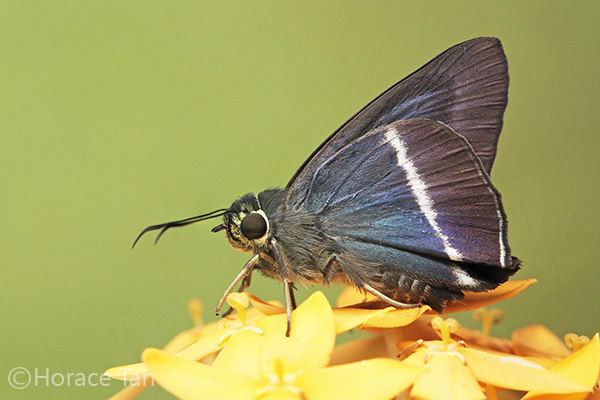Family Hesperiidae Rank Species | Genus Hasora Order Butterflies and moths | |
 | ||
Similar Hasora, Hasora chromus, Hasora badra, Badamia exclamationis, Hasora anura | ||
Hasora taminatus, the white banded awl, is a butterfly belonging to the family Hesperiidae, which is found in Asia.
Contents
Range
The butterfly is found in Sri Lanka, India, Myanmar, Thailand, Laos, Hainan, Hong Kong, western China, Malaysia, the Indonesian archipelago (Borneo, Sumatra, Java, Nias, Sumbawa and Bali), the Philippines and Sulawesi.
In India the butterfly is found in South India, where it occurs in the Western Ghats, Kodagu, Nilgiri mountains and Palni hills; and in the Himalayas from Mussoorie eastwards to Sikkim and through to Myanmar. It is also found in the Andaman and Nicobar islands.
The type locality is South India.
Status
William Harry Evans (1932) reports that it is common in South India and not rare elsewhere.
Description
The butterfly, which has a wingspan of 45 to 55 mm, is dark brown and unmarked above; and resembles the common banded awl (Hasora chromus), except that it has a broad white band on the under hindwing which is sharply defined. The female white banded awl has small spots on the upper forewing while the male has no brand above.
Detailed description
Edward Yerbury Watson (1891) gives detailed descriptions of H. t. malayana (C. & R. Felder, 1860), shown below:
Alls supra fuscis, subtus anticarum limbo costali, posticarum dimidio basali chalybaeis, his striga discali alba.
The females have a small semi-transparent yellowish discal speck between the two posterior branches of the median vein, and of course lack the oblique band of short lines of modified scales seen in the males of this as well as of the preceding closely-allied species." (Wood-Mason and de Niceville, J. A. S. B., 1881, p. 254.)
The above refers to Andaman females only, as in the Nicobar females the small semi-transparent yellow discal speck between the two posterior branches of the median vein is wanting according to Messrs. Wood-Mason and de Niceville.
Recorded from the Andamans and Nicobars.
Note: As H. t. malayana is sympatric with another subspecies, H. t. bhavara Fruhstorfer, 1911 in part of its range it has now been given specific status.
Host plants
The larva has been recorded on Derris scandens and Pongamia species.
